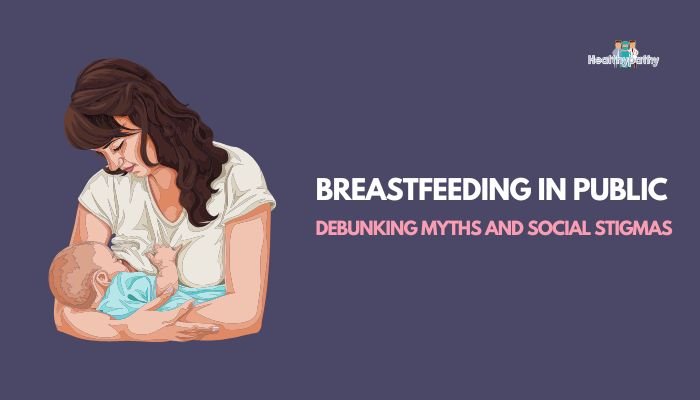Introduction
Breastfeeding is a natural, healthy way to nourish an infant—yet many mothers still encounter discomfort or negative reactions when doing it in public. Factors like cultural taboos, misconceptions, or simple lack of awareness contribute to the stigma surrounding nursing outside the home. In reality, breastfeeding is both beneficial and legally protected in many places. This article tackles common myths about breastfeeding in public, highlights the social and health benefits for mother and baby, and encourages communities to foster more acceptance and support.
Why Public Breastfeeding Matters
Health Benefits for Mother and Baby
Breastfeeding supports optimal nutrition, immune protection, and bonding. Offering these benefits on demand—wherever mother and baby might be—promotes stable feeding schedules and emotional connection. Nursing in public also helps mothers maintain milk supply, as missed or delayed feedings can lead to engorgement, lowered production, or mastitis risk.
Convenience and Normalization
When a baby is hungry, time is of the essence. Having to find a secluded spot or return home hinders a mother’s ability to go about daily life or social activities. Normalizing public breastfeeding reduces stress, encourages mothers to breastfeed for longer periods, and acknowledges that baby-led feeding is natural.
Common Myths and Misunderstandings
“It’s Indecent or Sexual”
Reality: The primary purpose of breasts for nursing mothers is to feed their infants, not to sexualize public spaces. Most women who breastfeed publicly do so discreetly and quickly, focusing on their baby’s needs rather than drawing attention.
“It Makes Others Uncomfortable”
Reality: While some individuals may feel unsure how to respond, the discomfort often stems from a cultural narrative that sees breasts solely as sexual or private body parts. Education and visible examples of normal breastfeeding can shift attitudes, making it less shocking for bystanders.
“Mothers Should Cover Up”
Reality: While some mothers choose a cover for personal comfort or style, not all babies tolerate covers, and not all mothers want or can use them. In many regions, the law protects a mother’s right to breastfeed without covering if she prefers.
“There Are Designated Places”
Reality: Infants can become hungry at any time and place, not just in “mother’s rooms” or restrooms. Breastfeeding wherever the mother is legally allowed to be can prevent baby distress and maintain consistent feeding routines.
Legal Protections for Breastfeeding Mothers
Varying by Country and State
Laws differ globally, but many countries and U.S. states have legislation affirming a woman’s right to breastfeed in public or private locations. Checking local regulations can inform mothers of their legal recourse if they experience harassment.
Workplace Rights
Employed mothers in certain regions are entitled to break time and a private space to pump breast milk (not a bathroom). This support ensures continued milk production even when mothers are away from their babies.
Public Spaces and Discrimination
If asked to “cover up” or leave due to breastfeeding, it may be grounds for complaint under anti-discrimination or breastfeeding-specific statutes—particularly if local laws explicitly protect the act of breastfeeding in public.
Practical Tips for Comfortable Public Breastfeeding
Start with Supportive Outfits
- Nursing Tops or Bras: Designed for easy and discreet access.
- Layers or Scarves: Offer coverage if you wish, though not mandatory.
Practice at Home
If you’re new to breastfeeding, practicing latch and hold positions in comfortable settings can boost confidence when you’re in more public areas.
Identify Friendly Spaces
Many cafes, stores, and public areas are recognized as “breastfeeding-friendly.” Knowing where these are can reduce worry about potential negative reactions or limited privacy.
Bring a Companion
Some mothers feel more at ease having a friend, partner, or family member present. They can offer moral support and help manage older children if needed.
Changing Attitudes and Moving Forward
Public Perspective
Increasingly, celebrities, social media influencers, and everyday mothers share images or stories of breastfeeding in public. This visibility fosters acceptance, normalizing the act and diminishing shock or stigma.
Community and Education
- Sensitivity Training: Businesses or workplaces that train staff to respect nursing mothers can create more inclusive experiences.
- Peer Support Groups: Local or online communities let mothers exchange advice and reassurance about feeding in public, building collective confidence.
Conclusion
Breastfeeding is the most natural method to feed an infant, and having the freedom to do so anywhere significantly lightens a new mother’s routine. Myths depicting public breastfeeding as indecent or best kept hidden stem from outdated social norms rather than scientific or legal justifications. By understanding legal protections, using modesty strategies where desired, and reinforcing the normalcy of feeding on demand, mothers can nurse confidently in public settings. Ongoing advocacy and societal acceptance continue to pave the way for a future where meeting a baby’s nutritional and emotional needs—whenever and wherever—remains universally supported.
References
- World Health Organization (WHO). Protecting, promoting, and supporting breastfeeding. 2020.
- American Academy of Pediatrics (AAP). Breastfeeding guidelines: infant nutrition best practices. 2022.
- La Leche League International. Your rights to breastfeed: global efforts. 2019.
- U.S. Department of Health and Human Services. Workplace and public breastfeeding laws. 2021.







